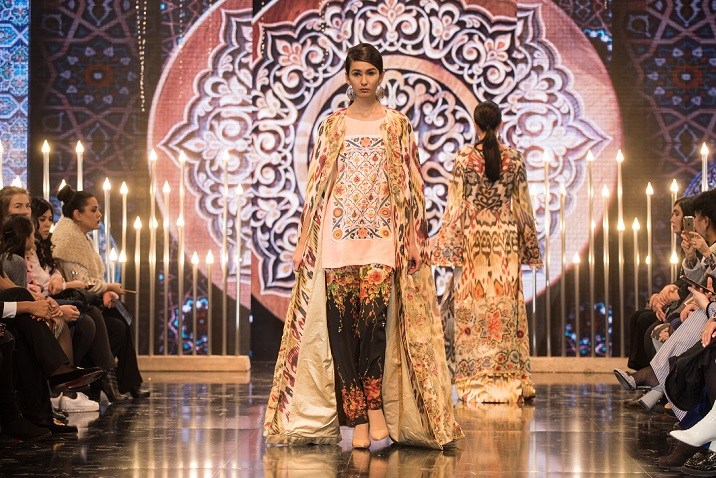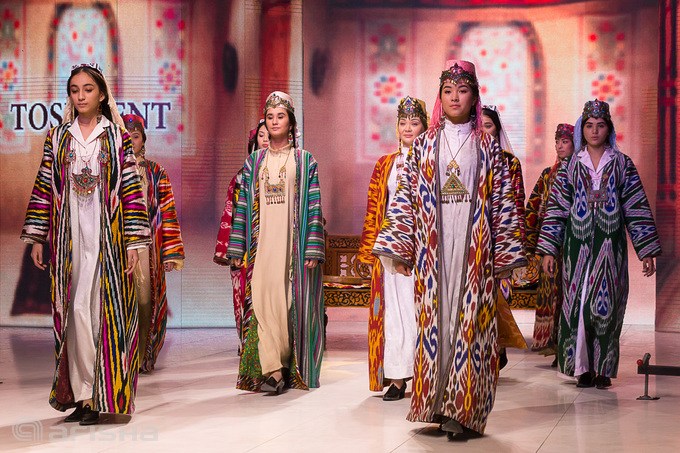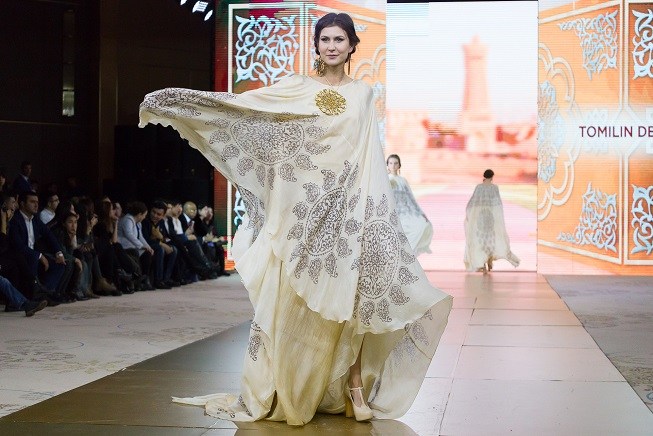Promoted by the Embassy of Uzbekistan in Brussels. The views belong to the sponsor.
Certain "standards" are developed, fixed and cultivated in each cultural and historical system. This system is usually applied to household items (dishes, utensils), jewelry (beads, rings), clothing, furniture, tools, etc. The history of fashion is inextricably linked with the history and development of the costume itself. However, it is impossible to put an equal sign between them.
Creating fashionable costume is a constant search for new forms and designs of clothing, color and decorative solutions, and as a result - a new image.
Every epoch, every national culture creates its own unique style. In some cases, the "own", national ideology of design is being developed. Folk clothes and shoes, created over many centuries, are an integral part of culture. The forms of clothing, their constructive and decorative solutions depended on climatic conditions and the level of development of productive forces, on the occupations of the people and the prevailing historical conditions. It also reflects traditions rooted in ethnic history, social relations, ethnic norms and much more.
In the history of Uzbek costume, as in the costume of any other era and country, an inseparable synthesis as the level of development of material culture (production) are reflected. Ethnic origin, climate, moral norms developed by religion, etiquette, social status, age characteristics, specifics of labor activity, trade and cultural ties, household traditions also play an essential role in the formation of the costume of the nation and the people.
Since ancient times, Uzbekistan has developed a costume complex that ideally meets climatic conditions and spatial and geographical habitat. Uzbek men's and women's national clothing consisted of lower, undergarment and upper – shoulder and waist. Yachtaks, light and quilted on cotton shirts; wool, fur coats, fabric-covered chakmans, camisoles, trousers, waist scarves, kulokhs and skullcaps, turbans and fur hats as an assortment of men's clothing; robes, dresses, burqas, shawls, skullcaps that make up women's clothing represent the main types of Uzbek national clothing.
The forms and design of the national costume are directly dependent on the type of material, its plastic properties, pattern, texture, color. The principles of compositional construction of a folk costume, clarity of forms, lines, thoughtful design, subordination of the decor to the cut, compliance of the material and shape with the purpose of the costume for a modern specialist are an example of a design approach to creating modern samples.
The cut of national clothes is simple and economical. When creating clothes, folk craftsmen tried to use the material completely, with whole panels, not to cut it, which is due to the width of the homespun cloth. In the matter of the aesthetic solution of the costume, the people proceeded from the beauty of the material, from the shape and design of the thing.
It is based on the principles and characteristic features according to which the cut was formed, ornaments were placed, individual parts were combined into one or another ensemble. It was established by customs and time when, what kind of clothes and in what combination to wear. Cotton, silk, semi-silk and wool fabrics were the main materials for making Uzbek clothing in the XIX century.
The abundance and cheapness of raw materials contributed to the development of various types of weaving in the cities of Central Asia. Weaving was divided into two main types: the production of the most common, publicly available cotton and more expensive, rich silk fabrics. The production of cotton fabrics was mainly carried out by women, silk and semi-silk - by men.
Entire cities specialized in the production of fabrics of certain varieties and colors. There were local schools of artistic weaving. All this contributed to the development of the art of dyeing fabrics, the addition of their local styles, colors and patterns. Amazing in beauty, high-quality fabrics have been famous throughout the East since the early Middle Ages, when the Silk Road passed from China through ancient Uzbekistan. Tashkent artisans produced calico or karbos (ordinary cotton unpainted cloth), basma (printed calico, mainly red), alacha, striped silk fabrics.
In Bukhara, Samarkand, Kokand, Margilan, Namangan and other cities, traditional silk fabrics were produced – shoya, khanatlas and semi-silk - bekasab, banoras, adras, velvet with abrov patterns, clothes from which were intended for the nobility.
The specifics of the production of Central Asian fabrics and the climatic features of certain regions of Uzbekistan predetermined the regional and local features of their costume.
Tashkent has long been of great importance as a major center and played the role of an intermediary in the trade of Central Asia with other neighboring countries, especially with Russia. The Fergana Valley has always been the pearl of the country, a source of raw materials. The residents of Tashkent and the Ferghana Valley differed little from each other in their lifestyle, clothes, their costumes are of the same type and differ from other regions in calm tones.
In the Ferghana Valley and in Tashkent, black and green colors prevailed, and women were very interested in fabrics. In addition, the Fergana Valley and Tashkent are among the richest regions of the Republic of Uzbekistan. They were the nodal points on the Great Silk Road and therefore were a kind of "trendsetters" in national clothes.
Bukhara has been the capital of the Bukhara khanates and the residence of the Bukhara emirs for several centuries. Samarkand was the capital of the empire of Amir Timur and the Timurid state. This is probably why the national clothes of Bukhara and Samarkand differ from other regions in their luxury, splendor, grandeur and unique gold embroidery. They decorated mainly court clothes, accessories of men's and women's costumes: robes (chapans), belts, hats and shoes.
Kashkadarya and Surkhandarya oases are located in the south of Uzbekistan. This region is characterized by a hot climate and an abundance of sunny days. Based on this, the national clothes of the inhabitants of the region are adapted to natural conditions. Bright, juicy colors, loose fit and unique, diverse embroideries testify to the high taste of the masters of the technique of execution.
The women of Surkhandarya were very fond of red, cherry, orange, purple and green colors, striped, smooth and abrov fabrics with large patterns and various embroidery. In Kashkadarya and Shakhrisabz, the technique of yurma and kandahael is used and the method of embroidery is widespread, which make it different.
Khorezm is an ancient cultural oasis located in the north of Uzbekistan, characterized by a sharply continental climate, hot summers and harsh winters. The national dress of the Khorezm region is distinguished by its features: the traditional rigor of its color scheme, the peculiar shape of headdresses (telpak-chugurma for men and lachak for women), an abundance of jewelry.
Despite the specific features of each region, they all make up a unique ensemble of Uzbek national costume, complement each other and reflect the aesthetic tastes of the Uzbek people.
Uzbek designers, striving to be in line with modern trends in world fashion, pay priority attention to the creation of collections in which the richest traditions of the national heritage are creatively reinterpreted. Their work demonstrates the awareness that the uniqueness of our art lies in its ancient historical roots, deep artistic traditions, in the spiritual experience that the historical costume conveys to us.
The search for the national identity of the modern costume led designers, mainly, to the use of cotton fabrics of local production, gold embroidery, to the use of some constructive and technological techniques (tunic-like cut and quilted clothing, tambour embroidery), the inclusion of dressing gowns, bloomers, skullcaps and turban-like hats, traditional jewelry in the costume complex.
The Uzbek national costume is distinguished by a variety of shapes and images, unusual structural and compositional solutions, colorful elements, elegance and unique decor, and especially embroidery. This is a big and fascinating world, possessing inexhaustible vitality for a contemporary. This is a kind of academy of knowledge and creative ideas for specialists of modern costume.
Analyzing the history of the national costume, considering the modern costume, we can conclude that any modern costume should show the features of folk, national, traditional, which makes the costume more organic, more original, more native, closer, more expensive. At the same time, one should always take into account the fact that costume and fashion are an international phenomenon; therefore, it would be unfair to exclude the mutual influence of costumes and fashion from all countries of the world. Achieving unity in diversity and diversity in unity is the way of development and renewal of modern costume.
Dr Khalida Kamilova, Chairman of the Osiyo Ramzi Association





